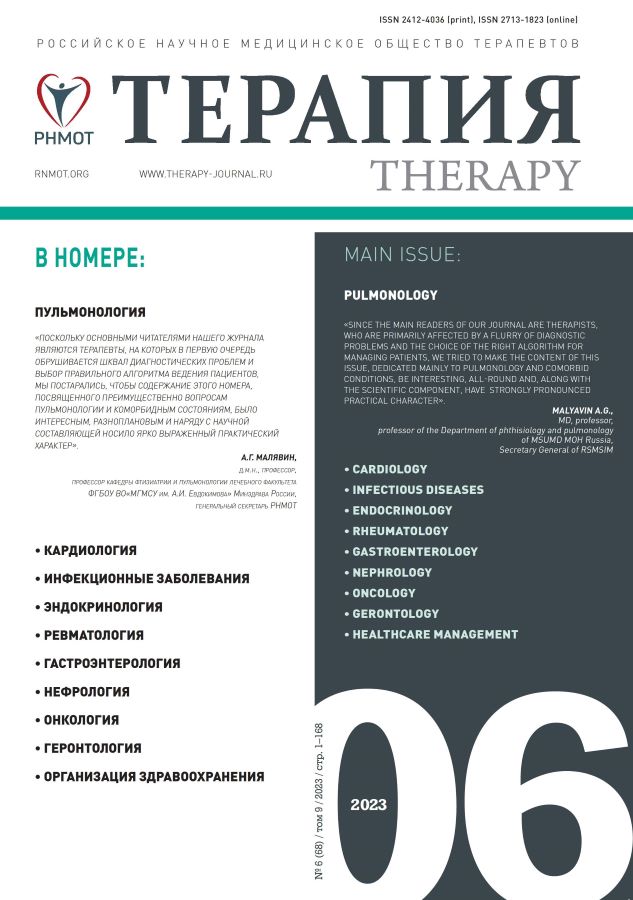Current aspects of the clinical course and outcomes of stable coronary heart disease in patients in the Republic of Dagestan
- Authors: Mammaev S.N.1, Chamsutdinov N.U.1, Panahova D.Z.1, Makhachev O.A.1
-
Affiliations:
- Dagestan State Medical University of the Ministry of Healthcare of Russia
- Issue: Vol 9, No 6 (2023)
- Pages: 24-31
- Section: ORIGINAL STUDIES
- URL: https://journals.eco-vector.com/2412-4036/article/view/624500
- DOI: https://doi.org/10.18565/therapy.2023.6.24–31
- ID: 624500
Cite item
Abstract
Within the population with stable angina, depending on the initial clinical, functional and anatomical factors, the individual prognosis can vary significantly.
The aim: to study the influence of various factors at the clinical course and outcomes of stable angina for secondary preventive measures optimization in patients in the Republic of Dagestan.
Material and methods. A retrospective, observational, cohort study was performed in 85 patients hospitalized on a planned basis from 01/01/2015 to 12/31/2017 with diagnosis «CHD. Stable exertional angina pectoris» in Dagestan Center for Cardiology and Cardiovascular Surgery (DCC and CVS). To clarify the clinical course and outcomes of the disease, all patients with whom telephone contact was established and who were alive were invited to the DCC and CVS for re-examination.
Results. During the observation period, a positive dynamic in the development of stable coronary artery disease was fixed. A rather low mortality rate was observed (only 5 patients from 85). Also during the study, there was fixed a decrease in the frequency of detection of a clinic of stable angina pectoris, patients adapted to the target levels of systolic and diastolic blood pressure with medication, they had less dyslipidemia. At the same time, a negative tendency in indexes of total cholesterol level was observed, which occurred due to the extremely low adherence of patients to lipid-lowering therapy. In the study, progression of the stage of chronic heart failure was observed, more frequent development of atrial fibrillation, in addition, not for all patients who needed myocardial revascularization, it was actually done.
Conclusion. Improving compliance with the prescribed drug therapy, more active educational work concerning the necessity of myocardial revascularization among patients will help improve the clinical course and outcomes of stable coronary artery disease.
Full Text
About the authors
Suleiman N. Mammaev
Dagestan State Medical University of the Ministry of Healthcare of Russia
Email: hepar-sul-dag@mail.ru
md, professor, professor of the department of hospital therapy
Russian Federation, 367000, Makhachkala, 47 Lyakhova Str.Nabi U. Chamsutdinov
Dagestan State Medical University of the Ministry of Healthcare of Russia
Email: nauchdoc60@mail.ru
md, professor, head of the department of faculty therapy and occupational diseases
Russian Federation, 367032, Makhachkala, 60a Dzhambulatova Str.Diana Z. Panahova
Dagestan State Medical University of the Ministry of Healthcare of Russia
Email: panaxova92@mail.ru
assistant at the department of faculty therapy and occupational diseases
Russian Federation, 367032, Makhachkala, 60a Dzhambulatova Str.Osman A. Makhachev
Dagestan State Medical University of the Ministry of Healthcare of Russia
Author for correspondence.
Email: oamakhachev@mail.ru
md, professor, head of the department of cardiology and cardiovascular surgery
Russian Federation, 367032, Makhachkala, 60a Dzhambulatova Str.References
- World Health Organization. Cardiovascular diseases (CVDs).
- URL: https://www.who.int/en/news-room/fact-sheets/detail/cardiovascular-diseases-(cvds) (date of access – 02.07.2021).
- Timmis A.D., Feder G., Hemingway H. Prognosis of stable angina pectoris: Why we need larger population studies with higher endpoint resolution. Heart. 2007; 93(7): 786–91. https://dx.doi.org/10.1136/hrt.2006.103119.
- Мамутов Р.Ш., Мамараджапова Д.А. Прогностическая значимость факторов риска и анамнестических данных на смертность больных стабильной стенокардии при 5 летнем проспективном наблюдении (фрагмент регистра ОКС/ОИМ). Евразийский кардиологический журнал. 2017; (1): 44–48. [Mamutov R. SH., Mamaradzhapova D. A. The prognostic importance of risk factors and medical history data on the mortality of patients of stable angina at 5 years prospective study (fragment of the register ACS/AMI. Evrazijskij kardiologicheskij zhurnal. Yevraziyskiy kardiologicheskiy zhurnal = Eurasian Heart Journal. 2017; (1): 44–48 (In Russ.)]. EDN: YHEPWH.
- Knuuti J., Wijns W., Saraste A. et al. 2019 Рекомендации ЕSC по диагностике и лечению хронического коронарного синдрома. Российский кардиологический журнал. 2020; 25(2): 119–182. [Knuuti J., Wijns W., Saraste A. 2019 ESC Guidelines for the diagnosis and management of chronic coronary syndromes The Task Force for the diagnosis and management of chronic coronary syndromes of the European Society of Cardiology (ESC). Rossiyskiy kardiologicheskiy zhurnal = Russian Journal of Cardiology. 2020; 25(2): 119–182 (In Russ.)]. https://dx.doi.org/10.15829/1560-4071-2020-2-3757. EDN: TLYYDR.
- Кириченко А.А. Стабильная стенокардия напряжения: оценка прогноза и лечение. РМЖ. 2014; 22(2): 106–110. [Kirichenko A.A. Stable exertional angina: Assessment of prognosis and treatment. Russkiy meditsinskiy zhurnal = Russian Medical Journal. 2014; 22(2): 106–110 (In Russ.)]. EDN: SKBOZB.
- Толпыгина С.Н., Марцевич С.Ю., Гофман Е.А. с соавт. Опыт создания регистра для оценки исходов хронически протекающей ишемической болезни сердца: исследование «ПРОГНОЗ ИБС». Кардиоваскулярная терапия и профилактика. 2013; 12(1): 32–39. [Tolpygina S.N., Marcevich S.Yu., Gofman E.A. et al. Developing a register of outcomes of chronic coronary heart disease: CHD PROGNOSIS study. Kardiovaskulyarnaya terapiya i profilaktika = Cardiovascular Therapy and Prevention. 2013; 12(1): 32–39 (In Russ.)]. https://dx.doi.org/10.15829/1728-8800-2013-1-32-39. EDN: PWXBDZ.
- Лупанов В.П. Ишемическая болезнь сердца и сахарный диабет: вопросы диагностики, медикаментозного и хирургического лечения, прогноз (обзор). Медицинский совет. 2013; (3–2): 52–61. [Lupanov V.P. Coronary heart disease and diabetes: diagnosis, medical and surgical treatment, prognosis (a review). Meditsinskiy sovet = Medical Council. 2013; (3–2): 52–61 (In Russ.)]. EDN: RVEQJR.
- Толпыгина С.Н., Марцевич С.Ю., Деев А.Д. Влияние сопутствующих заболеваний на отдаленный прогноз пациентов с хронической ишемической болезнью сердца по данным регистра «ПРОГНОЗ ИБС». Рациональная фармакотерапия в кардиологии. 2015; 11(6): 571–576. [Tolpygina S.N., Marcevich S.Yu., Deev A.D. The influence of concomitant diseases on a long-term prognosis in patients with chronic ischemic heart disease according to the «PROGNOZ IBS» register. Racional’naya farmakoterapiya v kardiologii = Rational Pharmacotherapy in Cardiology. 2015; 11(6): 571–576 (In Russ.)].
- https://dx.doi.org/10.20996/1819-6446-2015-11-6-571-576. EDN: VJGICX.
- De Geest S., Sabate E. Adherence to long-term therapies: evidence for action. Eur J Cardiovasc Nurs. 2003; 2(4): 323.
- https://dx.doi.org/10.1016/S1474-5151(03)00091-4.
Supplementary files











